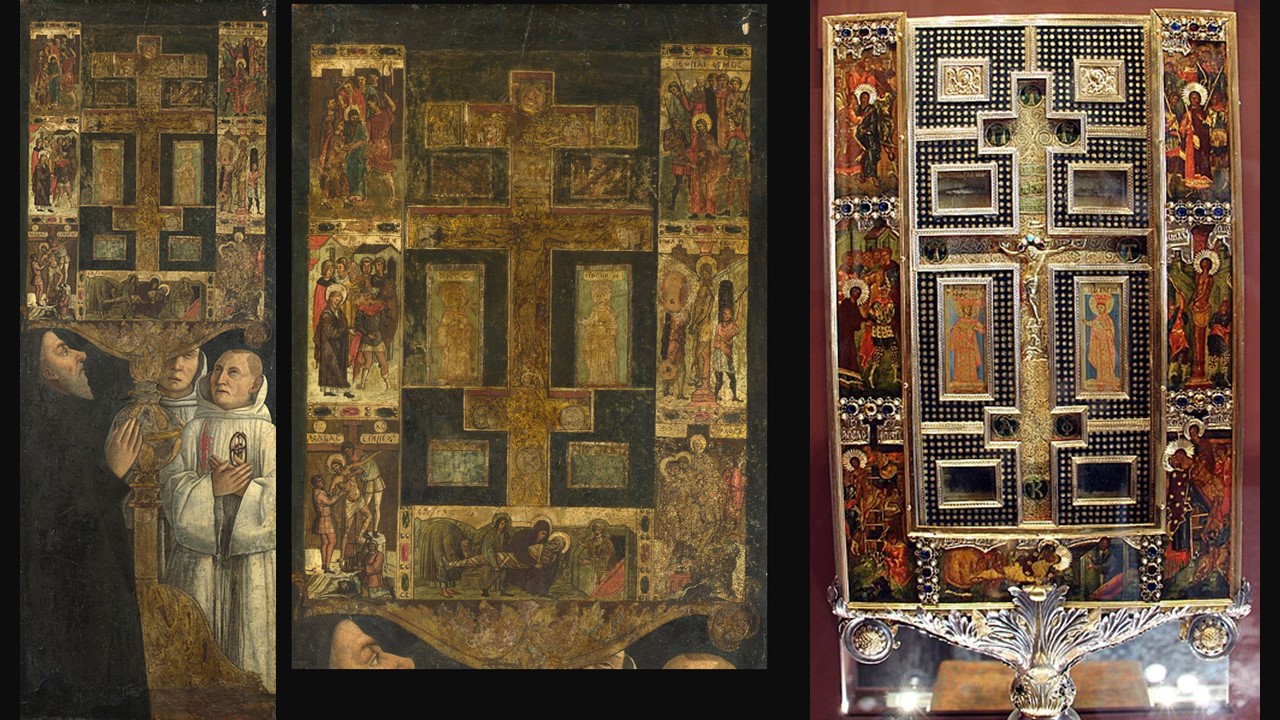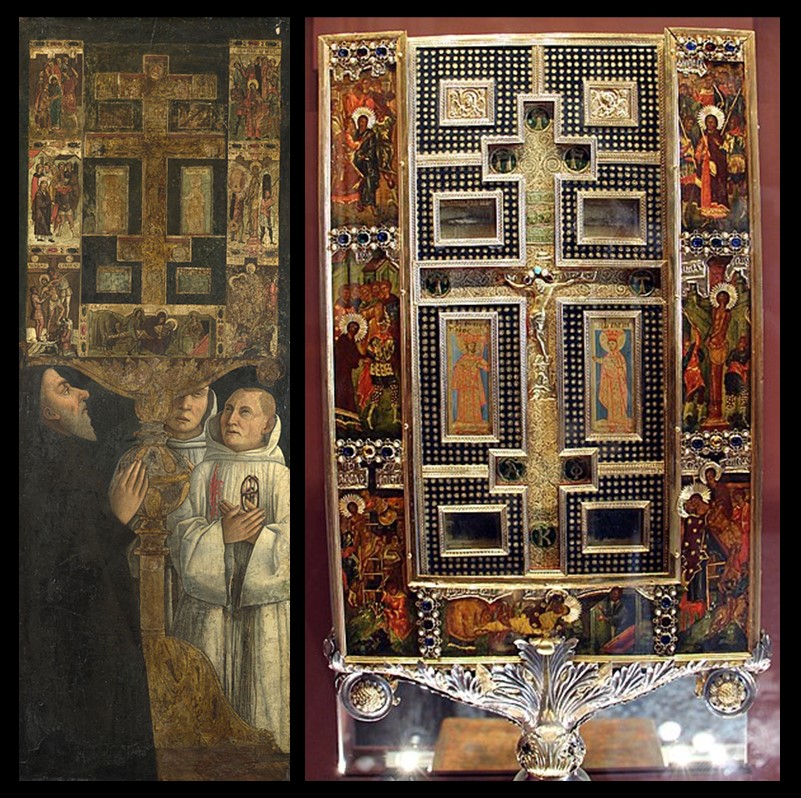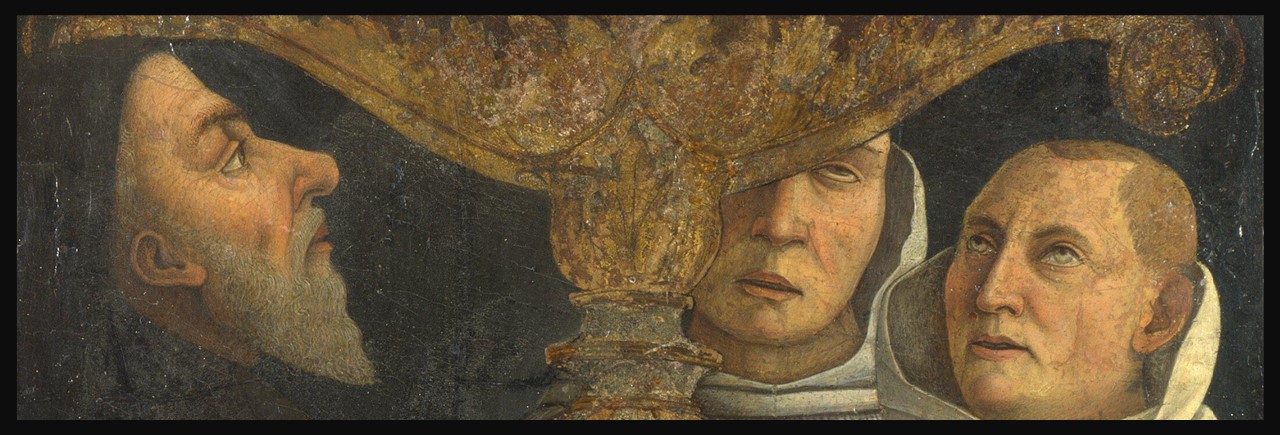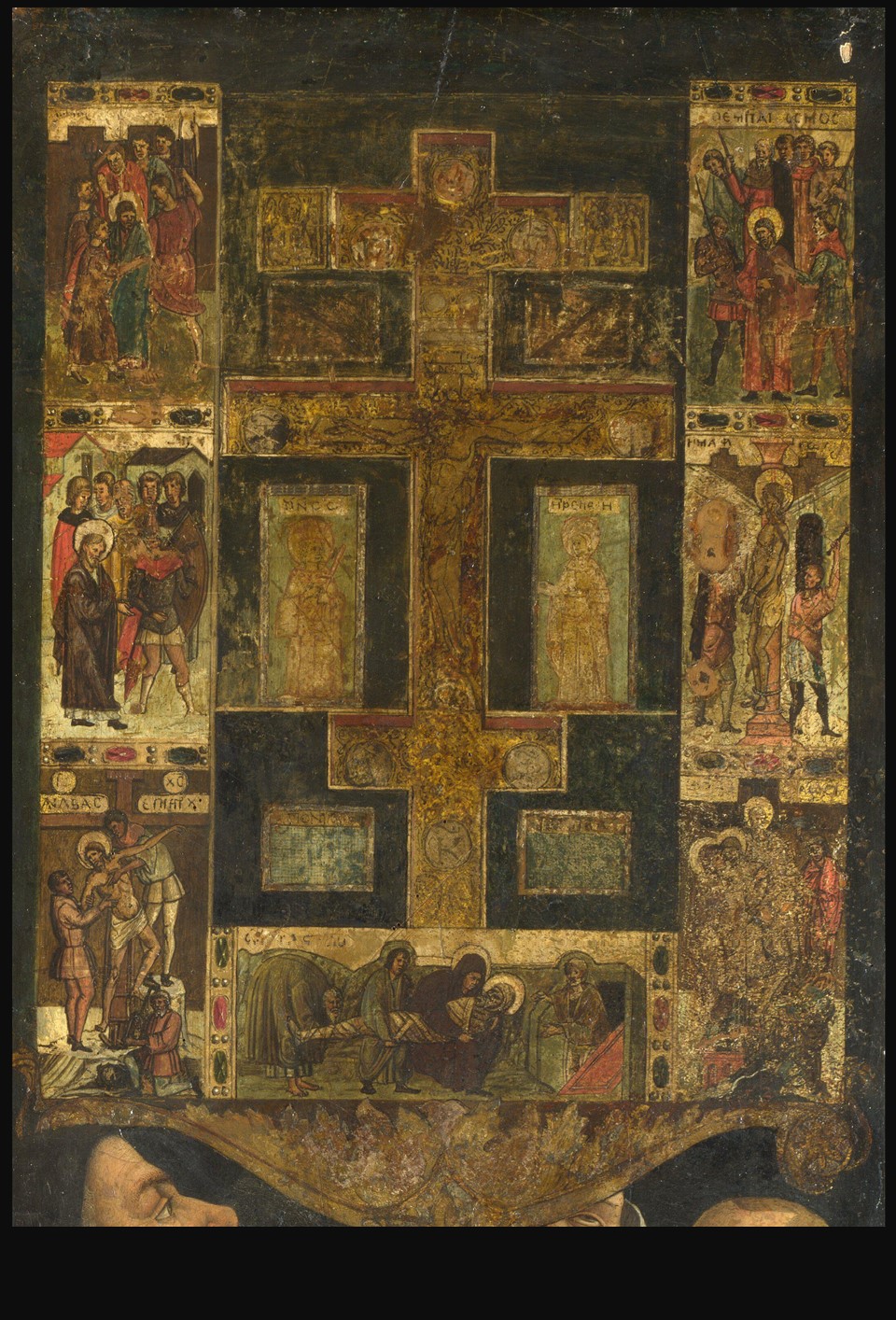
Cardinal Bessarion and Two Members of the Scuola della Carità in prayer with the Bessarion Reliquary, about 1472/3, Egg Tempera on Wood, 102.3 × 37.2 cm, The National Gallery, London, UK https://www.nationalgallery.org.uk/paintings/gentile-bellini-cardinal-bessarion-with-the-bessarion-reliquary
The Byzantine Reliquary of Cardinal Bessarion, late 14th-early 15th cent., Wood, silver, gilt filigree, enamel, glass, and precious stones, Galleria dell’Accademia, Venice, Italy https://www.gallerieaccademia.it/en/reliquary-cardinal-bessarion
The painting by Gentile Bellini depicting Cardinal Bessarion in prayer before his Byzantine Reliquary, accompanied by two Members of the Scuola della Carità, housed in the National Gallery in London, captivates my fascination. Bellini’s masterpiece not only offers a tangible link to the historical context it portrays but also illuminates the cultural milieu of its time. Functioning as both an artistic treasure and a captivating historical document, this work by Bellini is a testament to the rich tapestry of the past. https://www.nationalgallery.org.uk/paintings/gentile-bellini-cardinal-bessarion-with-the-bessarion-reliquary
Born Basilios Bessarion in 1403 in Trebizond, on the Black Sea, Bessarion emerged as a distinguished Humanist and a significant figure of the Renaissance. Initially devoted to a monastic life within the Eastern Orthodox Church, his trajectory took a pivotal turn during the Council of Ferrara-Florence. Here, he fervently advocated for the union of the Eastern and Western Churches, leading to his relocation to Italy. Immersing himself in the Renaissance’s revival of classical learning, Bessarion’s scholarly contributions and diplomatic acumen were acknowledged by Pope Eugene IV in 1439, culminating in his appointment as a Cardinal of the Catholic Church.
Beyond his ecclesiastical responsibilities, Cardinal Bessarion carried influence as a significant Arts Patron, amassing an extensive collection of Greek and Latin manuscripts including ecclesiastical and classical texts. His library considered a beacon of erudition, played a pivotal role in disseminating Greek knowledge to Latin-speaking scholars, thus nurturing the flourishing Humanist movement. This rich repository, comprising rare manuscripts and ancient texts, reflected Bessarion’s fervent commitment to preserving and transmitting the cultural heritage of both Eastern and Western traditions. This passion left a lasting mark on the intellectual landscape of the Renaissance. On May 31, 1468, Cardinal Bessarion bestowed his precious library upon the Serenissima Republic of Venice, endowing hundreds of rare manuscripts to shape the nucleus of the renowned library of St Mark’s, the Biblioteca Marciana.

Cardinal Bessarion and Two Members of the Scuola della Carità in prayer with the Bessarion Reliquary, about 1472/3, Egg Tempera on Wood, 102.3 × 37.2 cm, The National Gallery, London, UK https://www.nationalgallery.org.uk/paintings/gentile-bellini-cardinal-bessarion-with-the-bessarion-reliquary
The Byzantine Reliquary of Cardinal Bessarion, late 14th-early 15th cent., Wood, silver, gilt filigree, enamel, glass, and precious stones, Galleria dell’Accademia, Venice, Italy https://www.gallerieaccademia.it/en/reliquary-cardinal-bessarion
While Cardinal Bessarion is primarily celebrated for his scholarly contributions, efforts in reuniting the Eastern and Western Churches, and the establishment of his extensive library, he is also associated with a remarkable religious artifact known as Bessarion’s Reliquary or Staurotheke in Greek. This magnificent example of Late Byzantine craftsmanship, donated by Bessarion himself to the Scuola Grande della Carità in 1463, now forms part of the Collection of the Accademia in Venice. The Reliquary features a movable, gilded central Cross with origins traced back to the Byzantine princess Irene Paleologina. Encased within a wooden frame/box adorned with painted scenes depicting the Passion, intricate goldsmithing featuring blue-colored enameling, and flanked by the figures of Emperor Constantine and his mother Helena, the Cross also incorporates four chambers made of rock crystal. These chambers, situated on either side of the Cross, house the precious Relics of the True Cross and Christ’s robe.
Moving from the exploration of Cardinal Bessarion’s Reliquary to Gentile Bellini’s depiction of it, one can discern the symbiotic relationship between the historical artifact and the artist’s creative interpretation. Executed in 1972/73, precisely when Bessarion’s Reliquary made its way to Venice, Bellini was commissioned to craft a painted door panel. This panel was an integral component of a tabernacle designed to encase and safeguard the precious reliquary.

https://www.nationalgallery.org.uk/paintings/gentile-bellini-cardinal-bessarion-with-the-bessarion-reliquary
Gentile Bellini’s artistic pursuit not only captures the religious significance of the Reliquary but also breathes life into the personalities linked to its donation. The painting prominently features the generous donor, Cardinal Bessarion, portrayed in profile and modestly attired in black. Accompanying him are two distinguished members of the Scuola della Carità, adorned in their characteristic white robes. One of them is depicted holding an instrument for self-flagellation, projecting a sense of distinction and prominence. Despite the varied depictions, the central focus remains on Bessarion’s Reliquary, commanding attention in the composition. It serves as both a symbolic and visual anchor, connecting the historical artifact to the narrative brushstrokes of Bellini’s portrayal. Consequently, Bellini’s canvas emerges as a bridge between the tangible beauty of the relic and the nuanced storytelling of the individuals tied to it.

https://www.nationalgallery.org.uk/paintings/gentile-bellini-cardinal-bessarion-with-the-bessarion-reliquary
The Reliquary’s connection to Venice is beautifully narrated by Holgera A. Klein… In July 1463, ten years after the conquest of Constantinople (1453), Pope Pius II had sent Bessarion to Venice in an attempt to rekindle and promote the idea of a Crusade against the Ottoman Turks. Befitting his role as a Catholic Cardinal traveling as papal legate, the Doge and Senate went out to meet Bessarion in the lagoon on the Bucintoro, the doge’s great ceremonial barge, with chants, acclamations, and church bells resounding from all parts of the city. It was not the only honor bestowed on Bessarion in Venice, for on August 29, a few weeks after his arrival in Venice, Marco della Costa, the Guardian Grande of the Scuola della Carità, and a delegation of its most prominent members went to visit the Cardinal on the island of San Giorgio Maggiore and solemnly invited him to join their confraternity as a member. Touched by the city’s exhibit of respect, Bessarion, accepted the honor, accompanied the Scuola’s delegation back to the Rialto in festive procession, and vowed in gratitude to bestow a special gift on the Confraternity, namely his precious Stavrotheke, that previously belonged to Gregory III Melissenos, the Patriarch of Constantinople, with the sole provision that he would like to hold on to it during his lifetime. https://arthistory.columbia.edu/sites/default/files/content/faculty/pdfs/klein/Klein_estratto.pdf Cardinal Bessarion, Philippe de Mézières and the Rhetoric of Relics in late medieval Venice, by Holger A. Klein, pp. 23-26
In the spring of 1472, in Bolognia, on his way to France on yet another Papal mission, the ailing Bessarion decided to hand over the promised gift, which he had meanwhile ‘further adorned with silver, and fitted with a pole so that it could suitably be displayed in the context of pious devotion’. Three trusted men from the Cardinal’s familia were sent as couriers to hand over the precious panel, which, according to the confraternity’s reply, arrived in Venice in early June. At the request of the Venetian Senate the reliquary was first displayed on the high altar of San Marco on Trinity Sunday, and then carried in solemn procession through the city and across the Grand Canal into the Scuola della Carità accompanied by the entire populace chanting hymns…https://arthistory.columbia.edu/sites/default/files/content/faculty/pdfs/klein/Klein_estratto.pdf Cardinal Bessarion, Philippe de Mézières and the Rhetoric of Relics in late medieval Venice, by Holger A. Klein, pp. 23-26
What a magnificent story!
For a PowerPoint Presentation on Gentile Bellini’s oeuvre, please… Check HERE!
Information on the Conference ‘La Stauroteca di Bessarione: Restauro, Provenienza, Ambito Culturale tra Constantinopoli e Venezia’ (The Stauroteca of Bessarion: restoration, provenance, cultural context between Constantinople and Venice), organized by: Gallerie dell’Accademia, Istituto Hellenico, Veneto Institute of Sciences, Letters and Arts, in collaboration with the German Center of Venetian Studies, 17 – 18 October 2013 https://www.istitutoveneto.it/flex/cm/pages/ServeBLOB.php/L/IT/IDPagina/862
For Photographs of the Staurotheke’s restoration… https://leipsanothiki.blogspot.com/2014/10/359.html